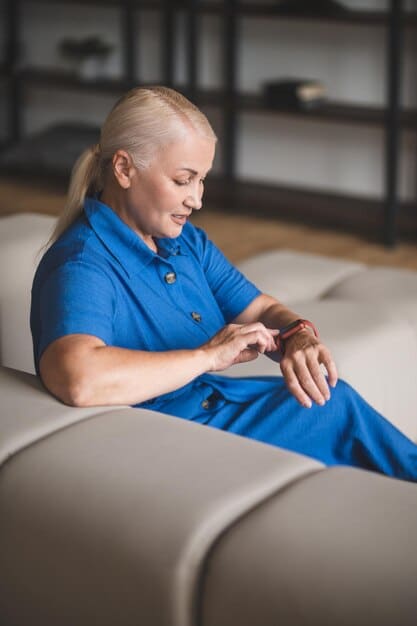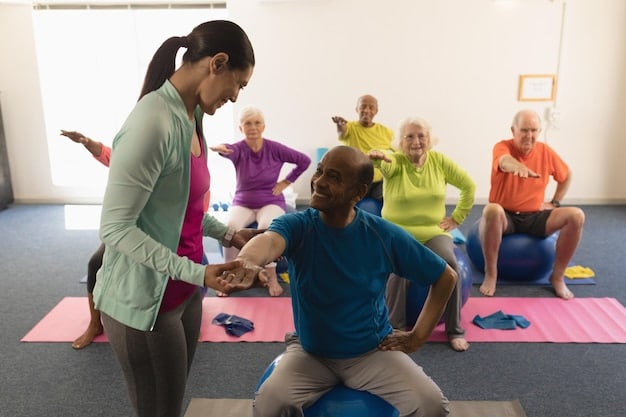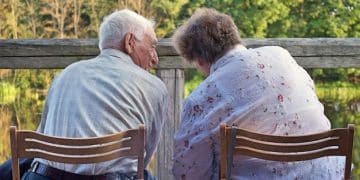Managing Chronic Pain in Seniors: Non-Opioid Therapies 2025

For seniors navigating chronic pain, a 2025 updated guide emphasizes the effectiveness and safety of non-opioid therapies, offering a comprehensive approach to enhance well-being without relying on traditional opioid medications.
Living with chronic pain can be a profoundly challenging experience, particularly for older adults. As we look towards 2025, understanding modern approaches to pain management becomes increasingly vital. This Updated Guide: How Seniors Can Manage Chronic Pain with Non-Opioid Therapies in 2025 explores various effective strategies that move beyond traditional opioid reliance, focusing instead on holistic, safer, and sustainable methods to improve quality of life.
Understanding Chronic Pain in Seniors: A New Perspective
Chronic pain is not merely an inconvenience; it’s a persistent condition significantly impacting a senior’s physical, emotional, and social well-being. Unlike acute pain, which signals immediate injury, chronic pain endures long after initial healing, often for months or even years. For older adults, this can be due to arthritis, neuropathy, previous injuries, or other age-related conditions.
The traditional reliance on opioid medications for chronic pain has come under scrutiny due to concerns about addiction, side effects, and potential for overdose, especially in an older population already managing multiple health conditions and medications. This shift has prompted healthcare providers and patients alike to explore safer, equally effective alternatives.
The Complex Nature of Senior Pain
Pain in seniors can be multifaceted, involving a combination of physical discomfort, psychological distress, and social isolation. Understanding these interwoven elements is crucial for effective management. Factors such as co-existing medical conditions, cognitive changes, and even financial limitations can influence how pain is perceived and treated.
- Physical Factors: Degenerative joint diseases, muscle weakness, nerve damage.
- Psychological Impact: Depression, anxiety, fear of movement, sleep disturbances.
- Social Implications: Reduced participation in activities, isolation, dependence.
Recognizing that pain is a subjective and personal experience, the approach to its management must be individualized, considering the senior’s overall health, preferences, and lifestyle. This holistic view emphasizes therapies that not only reduce pain but also enhance overall functional ability and mental well-being.
Pharmacological Non-Opioid Strategies for Pain Management
While the focus is on non-opioid options, it’s important to differentiate between various pharmacological approaches that can significantly mitigate chronic pain without the risks associated with opioids. These often serve as a first line of defense or as complementary treatments.
Non-steroidal anti-inflammatory drugs (NSAIDs) like ibuprofen or naproxen are common for mild to moderate pain, especially inflammatory conditions, but require careful monitoring in seniors due to potential kidney or gastrointestinal issues. Acetaminophen is often recommended for widespread pain, but liver function must be considered.

Topical Pain Relief Options
Topical medications offer localized pain relief with fewer systemic side effects, making them an excellent choice for many seniors. These include creams, gels, patches, and sprays that deliver pain-relieving ingredients directly to the affected area.
- Capsaicin Creams: Derived from chili peppers, these creams deplete substance P, a neurotransmitter that transmits pain signals.
- NSAID Gels: Topical forms of NSAIDs can reduce localized inflammation and pain, minimizing systemic exposure.
- Lidocaine Patches: These numb the area and are effective for neuropathic pain or localized musculoskeletal pain.
These topical solutions can be particularly beneficial for conditions like osteoarthritis in specific joints or localized neuropathic pain, providing targeted relief without the need for oral medication that travels throughout the body. Their ease of application and lower risk profile appeal to many older adults.
Antidepressants and Anticonvulsants for Neuropathic Pain
Interestingly, some classes of medications typically used for other conditions have proven highly effective in managing chronic neuropathic pain (pain caused by nerve damage). These include certain antidepressants and anticonvulsants.
Tricyclic antidepressants (TCAs) and serotonin-norepinephrine reuptake inhibitors (SNRIs) can modulate pain signals in the brain and spinal cord. Similarly, certain anticonvulsants, like gabapentin and pregabalin, are often prescribed to calm overactive nerve signals responsible for conditions such as diabetic neuropathy or post-herpetic neuralgia. These medications are not opioids and offer a different mechanism of pain control, making them valuable tools in a comprehensive pain management plan for seniors.
Physical Therapies and Exercise: The Cornerstone of Mobility
Physical therapy and tailored exercise programs are fundamental to chronic pain management in seniors. They address the root causes of pain by improving strength, flexibility, balance, and overall functional capacity, often reducing reliance on medication.
A qualified physical therapist can design a personalized program that includes gentle stretches, strengthening exercises, and low-impact aerobic activities, always considering physical limitations and pre-existing conditions. These programs educate seniors on proper body mechanics and pain coping strategies.
Tailored Exercise Programs
No single exercise program fits all. For seniors, the key is to find activities that are enjoyable, safe, and sustainable. Programs often start gently and gradually increase in intensity as strength and tolerance improve.
- Water Aerobics: Buoyancy reduces stress on joints, making movement easier and less painful.
- Tai Chi and Yoga: Improve flexibility, balance, and mindfulness, which can reduce pain perception.
- Walking: A low-impact exercise that improves cardiovascular health and joint mobility.
Consistency is paramount. Even short, regular sessions of activity can yield significant benefits, helping to maintain muscle mass, improve circulation, and release endorphins, the body’s natural pain relievers. The goal is not just pain reduction but also enhancing independence and quality of life through improved movement.
The Role of Occupational Therapy
Occupational therapists (OTs) play a crucial role by helping seniors adapt their daily living activities to minimize pain and maximize independence. OTs assess physical limitations and recommend tools, techniques, and environmental modifications to make tasks easier.
This might include ergonomic adjustments at home, teaching pain-sparing techniques for lifting or bending, or suggesting assistive devices like reachers or adaptive eating utensils. By reducing strain on painful joints or muscles during everyday tasks, occupational therapy empowers seniors to maintain their routines with greater comfort and less pain.
Integrative and Complementary Therapies
Beyond traditional medical interventions, a growing number of integrative and complementary therapies are proving effective in managing chronic pain for seniors. These approaches often focus on the mind-body connection and can be excellent complements to conventional treatments.
Acupuncture, for example, a traditional Chinese medicine technique, involves inserting thin needles into specific points on the body. It is believed to stimulate pain-relieving chemicals and modulate pain signals. Many seniors report significant relief from musculoskeletal pain, headaches, and nerve pain with acupuncture, often experiencing minimal side effects.
Mind-Body Techniques for Pain Control
The brain plays a powerful role in how we perceive pain. Mind-body techniques aim to harness this connection to reduce pain intensity and improve coping mechanisms. These therapies teach skills to alter the brain’s response to pain signals.
- Mindfulness Meditation: Focuses on present-moment awareness, helping to detach from pain sensations and reduce distress.
- Guided Imagery: Uses visualization to create calming mental images, diverting attention from pain.
- Biofeedback: Teaches control over involuntary bodily functions (like heart rate or muscle tension) to reduce pain.
These techniques empower seniors to take an active role in their pain management, providing tools they can use anytime, anywhere. By reducing stress and anxiety, which often amplify pain, mind-body practices can lead to tangible improvements in comfort and well-being.
Massage Therapy and Chiropractic Care
Hands-on therapies like massage and chiropractic care offer direct relief for many types of musculoskeletal pain. Massage therapy can relax tense muscles, improve circulation, and reduce inflammation, providing immediate comfort for conditions like back pain, neck pain, or fibromyalgia.
Chiropractic care focuses on spinal adjustments and alignment to reduce nerve irritation and improve joint function. For seniors with conditions like sciatica, spinal stenosis, or subluxations, chiropractic adjustments can often provide significant pain relief and improved mobility without medication. It is essential to seek out licensed and experienced practitioners in both fields who are familiar with the unique needs of older adults.
Lifestyle Modifications and Nutritional Support
Beyond clinical interventions, everyday lifestyle choices can profoundly impact chronic pain. Simple adjustments to daily routines, diet, and sleep habits can significantly contribute to pain reduction and overall well-being in seniors.
Maintaining a healthy weight is crucial, as excess pounds put additional strain on joints, particularly hips and knees. Even modest weight loss can lead to remarkable improvements in pain levels and mobility for seniors with osteoarthritis. This involves a balanced diet rich in anti-inflammatory foods and regular, gentle physical activity.
The Anti-Inflammatory Diet
Diet plays a significant role in managing inflammation, a common underlying factor in many chronic pain conditions. An anti-inflammatory diet emphasizes whole, unprocessed foods and limits those that promote inflammation.
- Consume: Fruits, vegetables, whole grains, lean proteins (fish, poultry, legumes), healthy fats (olive oil, avocados, nuts).
- Limit: Processed foods, refined sugars, excessive red meat, trans fats.
Specific nutrients like Omega-3 fatty acids (found in salmon, flaxseed) are potent anti-inflammatory agents. Incorporating turmeric, ginger, and other spices known for their anti-inflammatory properties can also be beneficial. A nutritionist or registered dietitian can provide personalized dietary guidance.
Importance of Sleep and Stress Management
Chronic pain and sleep are intricately linked; pain can disrupt sleep, and poor sleep can intensify pain perception. Prioritizing good sleep hygiene is therefore essential. This includes maintaining a consistent sleep schedule, creating a comfortable sleep environment, and avoiding caffeine and heavy meals before bedtime.
Similarly, chronic stress can exacerbate pain through increased muscle tension and heightened pain sensitivity. Techniques such as deep breathing, meditation, spending time in nature, or engaging in hobbies can significantly reduce stress levels, thereby helping to manage pain more effectively. Developing healthy coping mechanisms for stress is a powerful tool in any senior’s pain management arsenal.
Advanced Non-Opioid Interventional Procedures
For seniors whose chronic pain does not respond adequately to conservative non-opioid therapies, advanced interventional procedures offer targeted relief without systemic medication risks. These procedures are typically performed by pain management specialists.
Radiofrequency ablation, for instance, uses heat generated by radio waves to “turn off” nerve signals that are transmitting pain from a specific area, such as facet joints in the spine affected by arthritis. This can provide long-lasting pain relief, often for six months to a year or more, depending on the individual.
Nerve Blocks and Injections
Various types of injections can deliver pain-relieving medication directly to the source of pain, minimizing systemic side effects. These often combine an anesthetic for immediate relief with a corticosteroid for sustained anti-inflammatory effects.
- Epidural Injections: Used for back pain radiating down the legs due to nerve compression.
- Joint Injections: Administered directly into arthritic joints (e.g., knee, shoulder) to reduce inflammation and pain.
- Nerve Blocks: Target specific nerves to temporarily or permanently block pain signals.
These procedures are minimally invasive and can provide significant relief, allowing seniors to participate more effectively in physical therapy and improve their overall function. They are often utilized when diagnostic imaging confirms a specific source of pain that can be directly addressed.
Spinal Cord Stimulation (SCS) and Dorsal Root Ganglion (DRG) Stimulation
For severe, persistent neuropathic pain that has not responded to other treatments, neuromodulation techniques like Spinal Cord Stimulation (SCS) or Dorsal Root Ganglion (DRG) Stimulation can be life-changing. These involve implanting a small device that sends mild electrical impulses to the spinal cord or specific dorsal root ganglia.
These impulses interfere with pain signals traveling to the brain, replacing pain with a tingling sensation or, with newer systems, no sensation at all. Seniors often undergo a trial period to assess effectiveness before permanent implantation. These advanced therapies offer an effective, non-opioid pathway to profound pain relief for complex conditions like failed back surgery syndrome or complex regional pain syndrome.

The Importance of a Multidisciplinary Approach in 2025
Effective chronic pain management in seniors in 2025 is rarely achieved with a single intervention. Instead, it requires a comprehensive, multidisciplinary approach that integrates various therapies and involves a team of healthcare professionals. This collaborative model ensures all aspects of a senior’s pain experience are addressed.
A pain management team might include a primary care physician, pain specialists, physical and occupational therapists, psychologists, nutritionists, and acupuncturists. Regular communication among team members ensures a coordinated and tailored treatment plan that evolves with the senior’s needs.
Patient Education and Empowerment
Central to this multidisciplinary approach is empowering the senior through education. Understanding their pain condition, the treatment options available, and how to actively participate in their care plan is vital for long-term success. Education can help debunk myths about pain, reduce fear, and foster a sense of control over their condition.
Seniors who are well-informed are more likely to adhere to treatment plans, engage in self-management strategies, and advocate for their own needs. This partnership between patient and healthcare provider is key to achieving optimal pain relief and improving quality of life.
Future Outlook: Combining Therapies for Optimal Results
As we move further into 2025, the trend in chronic pain management will continue to emphasize combining therapies to create highly individualized and effective treatment plans. For instance, a senior might benefit from judicious use of topical medications alongside regular physical therapy, complemented by mindfulness practices and dietary adjustments.
Advanced interventional procedures may be integrated strategically when conservative measures are insufficient, opening doors to relief that opioids alone could never provide without significant risk. This holistic, patient-centered vision promises a future where seniors can live with significantly less pain and more independence.
| Key Aspect | Brief Description |
|---|---|
| 💊 Non-Opioid Medications | Focus on topical pain relievers, NSAIDs, antidepressants, and anticonvulsants for specific pain types. |
| 🏋️ Physical & Occupational Therapy | Tailored exercises and strategies to improve mobility, strength, and daily function. |
| 🧘 Integrative Therapies | Includes acupuncture, massage, mindfulness, biofeedback, and chiropractic care for holistic relief. |
| 💡 Advanced Interventions | Nerve blocks, injections, and neuromodulation for targeted, long-lasting pain relief. |
Frequently Asked Questions About Senior Pain Management
Non-opioid therapies are increasingly preferred due to the significant risks associated with opioids in older adults, including addiction, cognitive impairment, falls, and adverse drug interactions. Non-opioids offer safer, sustainable alternatives that address pain effectively without these dangers, aligning with improved patient safety and long-term well-being goals for seniors in 2025.
Absolutely. Lifestyle changes, such as maintaining a healthy weight, adopting an anti-inflammatory diet, ensuring adequate sleep, and managing stress, play a crucial role in reducing systemic inflammation and pain perception. These subtle yet powerful adjustments can significantly diminish pain intensity and improve overall quality of life for seniors.
Yes, when performed by experienced pain management specialists, advanced interventional procedures like nerve blocks or spinal cord stimulation are generally safe and effective for seniors. They are minimally invasive, offer targeted pain relief, and avoid systemic side effects of oral medications. Patient suitability is carefully assessed based on overall health and specific pain conditions.
Physical therapy is incredibly important, often considered a cornerstone of chronic pain management for seniors. It addresses underlying physical dysfunctions by improving strength, flexibility, and balance. Through tailored exercises and movement education, physical therapy empowers seniors to regain function, reduce pain, and enhance their independence without relying on medication.
A multidisciplinary approach involves a team of healthcare professionals, including doctors, therapists, and psychologists, working together to develop a comprehensive, individualized pain management plan. This collaborative effort addresses the physical, emotional, and social aspects of chronic pain, integrating various therapies for a more effective and holistic patient-centered outcome for seniors.
Conclusion and a Future of Better Pain Management
As we navigate 2025 and beyond, the landscape of chronic pain management for seniors is evolving, moving decisively towards safer, more sustainable non-opioid therapies. This shift represents a profound commitment to enhancing the quality of life for older adults by providing effective, individualized solutions that address pain in its entirety. Through a combination of pharmacological non-opioid options, robust physical and integrative therapies, thoughtful lifestyle modifications, and, when necessary, advanced interventional procedures, seniors can look forward to a future with substantially reduced pain and increased independence. The emphasis on a multidisciplinary, patient-centered approach empowers seniors to become active participants in their own healing, fostering a holistic pathway to well-being that prioritizes safety, efficacy, and enduring comfort.





